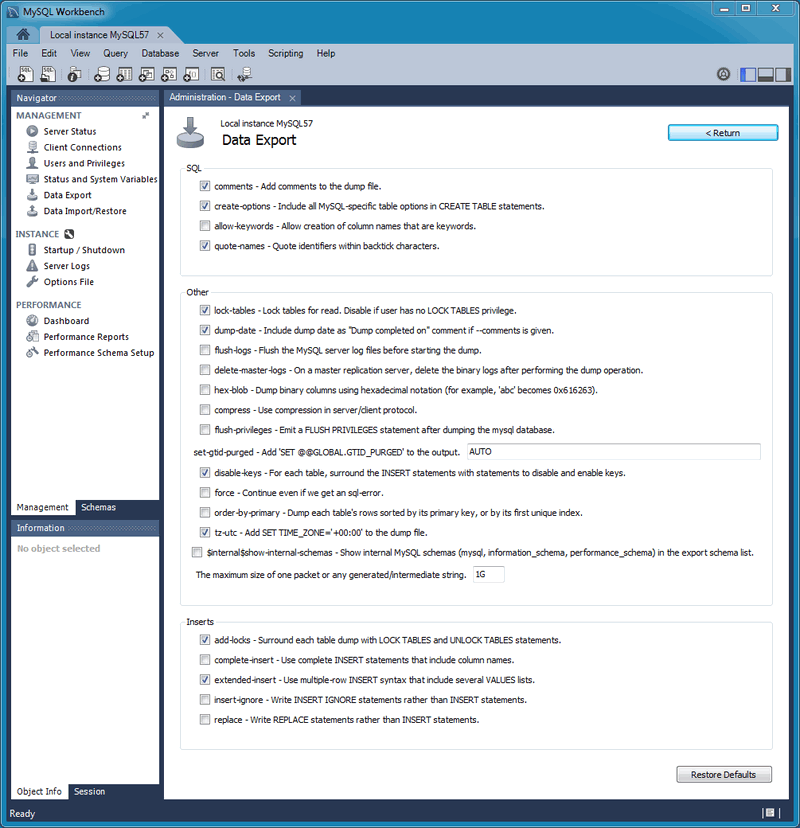

INTO OUTFILE statement to export the query results from within the query. You can also initiate the export via the MySQL Workbench Query menu: The Query menu also provides an “Export Results…” option. Here are the formats supported at the time of writing: You have a choice of file formats to save the file in. You can change that setting by clicking the Limit to 1000 rows dropdown and selecting Don't Limit. Be sure to remove this limitation if you don’t want your result set to be limited to that amount (or some other amount if it has been specified). Important: MySQL Workbench limits the result set to 1000 rows by default.

Here’s a screenshot: Clicking the Export button on the Result Grid toolbar allows you to export the query results to a file. Click Export on the Results Grid menu bar.Select Import from Self-Contained File and enter the location in the File Path text field.Ĭlick Start Import and enter the database password if prompted. This process may take several minutes depending on the size of your database backup.You can use MySQL Workbench to run a query, then export the results of that query to a file. Select which tables from the backup you would like to restore. Select Import from Dump Project Folder and enter the location in the Folder Path text field. This step will differ depending on which option you chose. When you created the backup you were presented with the option to export your database tables to a folder or a single self-contained file. If you cannot see this option, make sure the Home tab is selected. Restore your database from a previous backup Step 1Ĭlick Manage Import / Export under Server Administration on the right of the Workbench window.
#EXPORT DATABASE MYSQL WORKBENCH PASSWORD#
Export to Self-Contained File: All selected tables will be exported to one single SQL file.Ĭlick Start Export and enter the database password if prompted. Export to Dump Project Folder: MySQL Workbench will create a separate backup file for each table in your database, which will make it possible to store selected tables in the future without the need to restore the entire database. Click Select All Tables if you would like to export the contents of your entire database.Ĭhoose where you would like to save your database backup. In the Select Database Objects to Export section, select your database by checking the relevant box in the Export column. If you can't see this option, make sure the Home tab is selected.Įnter your database password if prompted. Step 1Ĭlick Manage Import / Export under Server Administration on the right of the Workbench window. We strongly recommend that you create regular backups of your database so it can be easily and quickly recovered in the unlikely event that your data is lost or becomes corrupted. Step 4Įnter your database password when prompted. Default Schema: Enter the name of your database.Ĭlick Next when you have entered the details. Username: The username of your database owner as chosen during your MySQL setup. Hostname: The IP address of the MySQL database server you have been allocated. Connection method: Ensure Standard (TCP/IP) is selected.  Connection name: Enter a name to allow you to easily identify the database. Tutorial: Migrate data from a MySQL 5.6 database to a newer database version in Amazon Lightsail. On this page enter the following details: Select Remote Host, enter the IP address of your database server in the Address text field, and click Next.
Connection name: Enter a name to allow you to easily identify the database. Tutorial: Migrate data from a MySQL 5.6 database to a newer database version in Amazon Lightsail. On this page enter the following details: Select Remote Host, enter the IP address of your database server in the Address text field, and click Next. 
The Create New Server Instance Profile window will appear. Open MySQL Workbench and click New Server Instance on the right of the window.
A Database user How Do I Change the Owner Password for My Database?īefore you begin you need to define a connection to the database server. How do I add a MySQL database to my account?








 0 kommentar(er)
0 kommentar(er)
